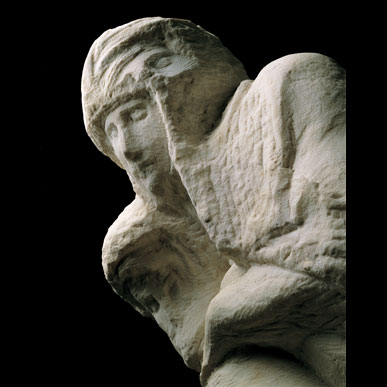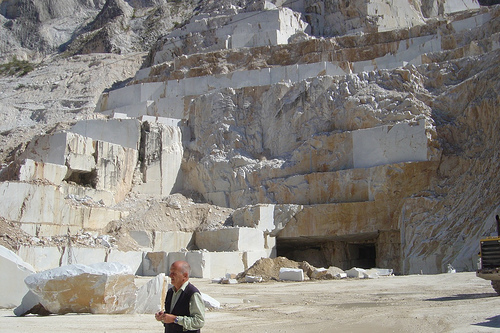Carving by the Michelangelo Quarry

CARRARA - I am carving a block of marble from the Michelangelo Quarry in Carrara in an outdoor studio by the side of the road that leads to that quarry. I am told that where I am standing is the old road that Michelangelo would have walked daily going to the city below and to the quarries above.
Even though Michelangelo is a large industry here, no one has bothered to learn in particular how he carved, that very thing which most reveals how he thought, indeed that individual attribute which explains why he was such a great artist.
I carve using the same tools and the method that the great sculptor used. It is not due to any brilliance or even diligence on my part. It is due to the fact that I had no other teacher. I was trained in drawing and painting at Rhode Island School of Design. I moved to Vermont, not far from Vermont Marble Company. The roadbed was raised with rubble, waste marble, from the quarry. I picked up a boulder and tried to carve it with a screwdriver. Eventually some better tools enabled me to cease hitting that same thumb bone. But still there was no teacher.
I studied Michelangelo's marble sculptures. I did not want to read the endless discussions by the art historians about the socio-economic conditions of his life or their endless speculations about what this or that sculpture truly means. I cleared my mind and just looked at the sculptures for long periods of time. Things began to become evident from the physical record, like an archaeological record, especially from his many unfinished carvings. Oh, I see this tool came first, the point chisel, pushed by a heavy hammer leaving deep parallel grooves, roughing out the shapes, and it is followed by the toothed chisel going around the form, cross hatching.
By looking at how Michelangelo carved marble we can understand a great deal about how he thought. His sculptural process informed how he painted and how he designed architecture. Because that process is only subtractive it bears investigation - this is not the way that artists normally create.
The master sculptor's little understood and much discussed "Non- Finito" (unfinished) sculptures can only be understood in light of his carving methods. There still exists, among experts, considerable debate on the “non-finito”. Traditional art historians with their extensive knowledge of peripheral events in the artist's life will maintain that he was pulled from job to job by patrons and Popes. On the other extreme, romantic Modernists insist that he left works unfinished for self-expression.
Michelangelo's last Pietà, Pietà Rondanini, was the marble that he was working on six days before he died (see photo below). Note that there is the remnant on the top of the veil of the Virgin of her face looking in a completely different direction. This reveals an earlier version of the work and shows us how radically the master changed the composition. It also shows us how he thinks with his tools searching for forms and what tools he used to find big forms, the point chisel removing large chunks of stone, and the tooth chisel going around big shapes. He continues to draw as the sculpture progresses. He trusts his eyes. This separates him from other sculptors, even Gian Lorenzo Bernini the master of flying drapery in marble, because it was necessary for Bernini to follow his models more carefully. For Michelangelo it is a dialogue, it becomes like combat. Interesting that Raphael painted Michelangelo in his School of Athens as Hericlitus, the philosopher who said- the only thing constant is change.
Now, I wish to show that a true understanding of this unique practice, by a Renaissance artist, one who was paid to finish works, can only be grasped by understanding his relationship to the block of marble. I assert his intentionality with regard to the non-finito for two reasons. Contemporary scholar William Wallace has pointed out that Michelangelo had a sense of his own place in history and that he would always leave one job to go to a better one, to a better opportunity. His sense of himself allowed him to resist external pressures to finish works, to some degree. Secondly, we must assume that when someone does something repeatedly and consistently that it is intentional. Especially if he had shown good judgment in managing his projects before. Leaving some works in rough states is intentional.
The Non-Finito is a direct result of his technique. He uncovered forms within the block of stone and he finished some parts prematurely to aid his vision. Rather than relying on models that he had previously made, he preferred to draw, to measure with his eyes. In this way the process of carving was direct, immediate, open to change, and dynamic.
Michelangelo's carvings are dynamic because carving is not just a means to reproduce something conceived by modeling in clay, by adding on. Carving is a way of thinking, a way of seeing what is not yet there. Each tool leaves a surface rich in suggesting forms. For me now, even the point chisel breaking off large chunks of stone can leave a surface that will suggest, for example, drapery folds. It is similar to Leonardo's advice to artists to study stains on a wall or on paper and envision a landscape. It is collaborative as opposed to an imposition of will upon the material.



